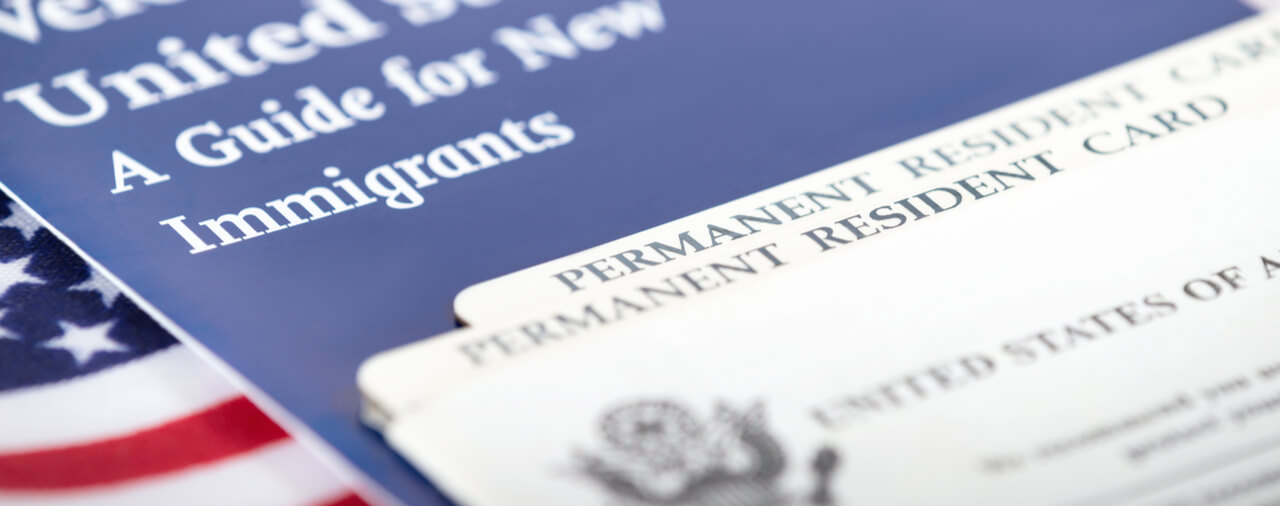- Introduction
- Eligibility Requirements For Asylees To Adjust To Permanent Resident Status
- Applying For Adjustment Of Status As An Asylee Or Derivative Asylee
- Post-Dating Lawful-Permanent Resident Status
Introduction
Persons who are granted asylum in the United States are eligible to apply for adjustment of status 1 year after receiving a grant of asylum after being physically present in the United States for one year. The spouses or children (henceforth, “derivative asylees”) of these asylees are also eligible to apply for permanent resident status 1 year after the grant of asylum, provided that they were admitted to the United States as asylees or were included in the principal asylee’s grant of asylum. This article will explain the eligibility requirements that asylees and their derivative asylees must satisfy to adjust to permanent resident status, and provide information about the application process.
Eligibility Requirements For Asylees To Apply For Adjustment Of Status
In order to apply for adjustment to permanent resident status,1 an asylee must:
Be physically present in the United States for at least one year from the date he or she received a grant of asylum
Continue to meet the statutory definition of “refugee”2 unless he or she was granted asylum prior to November 29, 19903
Not be firmly resettled in another country
Meet the requirements for admissibility to the United States4,5
Asylees are not required to apply for adjustment of status. However, since asylees will not be eligible to apply for adjustment of status as asylees if they no longer meet the requirements to be classified as “refugees,” asylees who want to apply for adjustment of status are well advised to do so as soon as they are eligible to do so.
In order to apply for adjustment to permanent resident status, a derivative asylee must:
Qualify as derivatives of the principal asylee
According to current United States Citizenship and Immigration Services (USCIS) policy, the derivative asylee’s relationship to the principal asylee must have existed prior to the grant of asylum.6 However, USCIS regulations are silent with regard to that requirement.7
Derivative asylees may adjust along with the principal asylee,8 or separately from the principal asylee provided that the principal asylee continues to qualify as a “refugee.” In the case of a derivative asylee spouse, he or she must remain married to the principal asylee in order to adjust through the principal.9
If a principal asylee dies, his or her spouse or child may apply for adjustment to permanent resident of status provided that the spouse or child was granted asylee status by virtue of his or her relationship with the principal asylee, that the spouse or child resided in the United States at the time of the principal’s death, and that he or she resides in the United States at the time of the adjustment of status application.10
If the derivative asylee spouse of a principal asylee and the principal asylee are divorced before the principal asylee adjusts status, the former spouse is ineligible to adjust through the principal asylee.11 However, the former spouse may file his or her own Form I-589, Application for Asylum and Withholding of Removal, and if approved, it will count retroactively to the date of the grant of derivative asylum.12 Upon approval, the former spouse may then apply for adjustment of status.13 Provided that the former spouse is from the same country as the former principal asylee, and that he or she independently meets the requirements for asylees being approved for adjustment of status, he or she may reasonably expect that the application will be successful.14 These same rules apply for children of principal asylees who have aged out of being able to adjust status along with the principal asylee.15
Provided that an unmarried child under the age of 21 is listed on his or her parents’ asylum (I-589) application on the date that the application is received by USCIS, he or she will continue to be classified as a child for the purposes of adjusting status even if he or she exceeds the age of 21 before adjustment.16
Applying For Adjustment Of Status As An Asylee Or Derivative Asylee
Eligible asylees may apply for adjustment of status on a Form I-485, Application to Register Permanent Residence or Adjust Status.17 USCIS provides a short guide for what an asylee filing for adjustment of status will need to provide.
Along with the Form I-485, the asylee must file:
Application fees for Form I-485 and fingerprinting (applicants less than 14 years of age do not need to submit a fingerprinting fee)
Form I-693, Report of Medical Examination and Vaccination Record
Copy of I-94 card
Form G-325A, Biographic Information Sheet (provided the asylee is between 14 and 79 years of age)
Two passport-style photos
Certified copies of court records (if the asylee was arrested)
Form I-602, Application by Refugee for Waiver of Grounds of Excludability (if the asylee needs to have a ground of inadmissibility waived in order to be approved for adjustment of status)
If the asylee is applying for adjustment of status for derivative asylees as well, he or she must prepare separate Form I-485s application packets for the derivative asylees. They may be submitted together.
Asylees who need to waive a ground of inadmissibility must file a Form I-602. The Attorney General (AG) may, in his or her discretion, waive any statutory ground of inadmissibility in this case except for those noted in footnote 19.18,19
If, during the pendency of the application to adjust status, conditions in the country that the asylee last habitually resided change such that the asylee can no longer reasonably fear persecution, the adjustment of status application may be denied.20 A denial on this ground is non-reviewable.21 However, the application may be renewed if the asylee is subsequently placed in removal proceedings.22
An asylee may travel abroad during the pendency of the adjustment of status application.23 If the applicant travels abroad but is inadmissible to return because of the lack of a valid refugee travel document, and did not depart under a grant of advance parole, the applicant will still be eligible to adjust status provided that he or she is paroled into the United States.24
Post-Dating Lawful-Permanent Resident Status
If the adjustment of status application is approved, the asylee’s date of admission for lawful permanent residence (LPR) will be recorded as of one year before the date of approval for LPR status. This means that if an asylee approved for adjustment of status had applied exactly one year after receiving a grant of asylum, that entire year will retroactively be counted as time spent as an LPR. Asylees who hope to eventually avail themselves to benefits that require time accrued as LPRs, such as naturalization, are thus well advised to apply for adjustment of status as soon as they are eligible.
- Pursuant to 8 C.F.R. § 209.2(a)(3), this also applies to aliens arriving in the Commonwealth of the Northern Mariana Islands after January 1, 2015
- “Refugee” is defined in INA § 101(a)(42) as a person who is unable or unwilling to return to the country he or she last habitually resided in on account of persecution, or a well-founded fear of persecution, on account of race, religion, nationality, membership in a particular political group, or political opinion. This includes persons who were forced to abort a pregnancy or undergo involuntary sterilization, or who were persecuted for refusing to submit to either. The definition excludes those who participated in any of the above types of persecution.
- 8 C.F.R. § 209.2(a)(2)
- If the principal asylee is inadmissible, he or she will need to obtain a waiver of the applicable ground of inadmissibility in order to be eligible to adjust status
- Citing for the entire list: S. Kurzban, Kurzban’s Immigration Law Sourcebook: A Comprehensive Outline and Reference Tool (AILA 14th Ed. 2014) 831, citing; 8 C.F.R. §§ 209.2(a), 1209.2(a); AFM at 41.6
- Kurzban 831, citing; Memo, Carmichael, Assoc. Comm., Examinations, “Asylum Procedures and Adjustment of Status” Co 208-P (May 18, 1984), reprinted in 61 Interpreter Releases 522-28 (June 29, 1984)
- Kurban 831, citing; 8 C.F.R. § 209.2(a)(1)(iii)
- Kurzban 831, citing; USCIS Policy Manual, Vol. 7, Part M; and AAPM III, E.7.
- Kurzban 831, citing; Memo, Gibson, Acting Assoc. Comm. Examination, INS CO-209-P (Oct. 4, 1985), reprinted in 62 Interpreter Releases 1030-31 (Oct. 25, 1985)
- Kurzban 832, citing; INA § 204(l)(2)(G)
- Kurzban 831, citing; Legal Opinion, Virtue, CO 209(b) (July 27, 1989)
- Kurzban 831, citing; AAPM III, E, 7.
- Id.
- Id.
- Id.
- Kurzban 832, citing; INA § 208(b)(3)(B); Matter of A-Y-M-, 25 I&N Dec. 791 (BIA 2012) [ruling that under CPSA, an unmarried child over 21 retains child status]; and Memo, Yates (Assoc. Dir. Operations, USCIS, HQOPRD 70/6.1 (Aug. 17, 2004), published on AILA InfoNet at Doc. No. 04091561
- Kurzban 832, citing; 8 C.F.R. §§ 209.1(b), 1209.1(b), 1209.2(c)
- Kurzban 832, citing; INA § 212(a)
- AG may not waive inadmissibility for controlled substance trafficking under INA § 212(a)(2)(C), entering the United States to engage in espionage, unlawful activity, opposition to the control of the U.S. government under INA § 212(a)(3)(A), terrorist activities under INA § 212(a)(3)(B), posing serious adverse foreign policy consequences for the United States under INA § 212(a)(3)(C), or participation in Nazi persecution, genocide, torture, or extrajudicial killing under INA § 212(a)(3)(E); see Kurzban 832 for the list of grounds of inadmissibility in the INA that the AG may not waive
- Kurzban 832
- Id.
- Kurzban 832, citing; 8 C.F.R. §§ 1209.2(c),(f)
- Kurzban 832, citing; Letter, Combs, Asst. Comm. CORAP (Dec. 20, 1988), reprinted in 66 Interpreter Releases 100, 116-17 (Jan. 23, 1989)
- Kurzban 832, citing; INA § 209(b); Memo, Cooper, Gen. Counsel, HXCOU90/15-P, reprinted in 77 No. 37 Interpreter Releases 1384, 1391-98 (Sept. 25, 2000)
Resources and materials:
Kurzban, Ira J. Kurzban’s Immigration Law Sourcebook: A Comprehensive Outline and Reference Tool. 14th ed. Washington D.C.: ALIA Publications, 2014. 831-832, Print. Treatises & Primers.
“Green Card for an Asylee” USCIS, July 17, 2015, retrieved July 23, 2015, available at www.uscis.gov/green-card/green-card-through-refugee-or-asylee-status/green-card-asylee [link]





